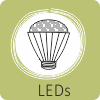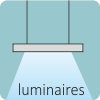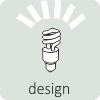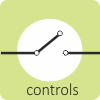- Lighting is designed based on the space functional requirement and user behaviour. Select possible lamps available in the market to meet the objective.
- Designer should estimate the basic lighting requirement based on the lux requirement for each lamp category and select lamp with best life cycle cost and energy saving potential.
- Consider Maintenance factor – The installed lighting should be design to meet the design requirement for a period of time. A gradual decrease of illuminance is observed in all lighting technologies with time because of following reasons:
- Lamp output reduction (Lamp lumen maintenance factor)
- Dirt on luminaire (Luminaire maintenance factor)
- Dirt on room surfaces (utilization factor)
- Optimize the lighting requirement based on the use of a simulation software. Many recognized softwares like Daysim, AGI 32, Dialux etc are available, which simulate the space with selected lamp and luminaire category and report the uniformity and lighting lux level achieved in a space.
- For a NZEB, designer should target a LPD reduction of at least 50% of the value stated in ECBC.
Design Considerations
Lighting Design Framework – holistic approach
An integrated design approach is necessary for lighting design. This can be done with six elements that influence lighting design. They all need to be considered for best possible solution.
- Visual Function- The key components within visual function are:
- Luminous Flux (Lumens): The amount of light coming from the light source (lumens) and is a measure of total power of light. It is measured in lumens. Lumen is used for comparing how bright the light source is. ( e.g. 60 W incandescent bulb is about 850 lumen). The amount of light that travels in certain direction from the source is called “luminous intensity” (measured in candles).
- Illuminance – The lighting level at the working desk or a space should be adequate and comfortable. NBC provides the average lux level required for each space category.
- Uniformity of Illuminance: Uniformity is an integral fundamental for visual performance and discomfort. Variation on illuminance not only hampers the overall appearance of a space, but also to the comfort levels and energy consumption.
- Glare – Glare is an unusual and un intentional excessively bright area which, directly or indirectly, leads to discomfort visual glare or disability glare.
- Surface colours – The visual aesthetics and appearance of an object or space is resultant of material specification of the target and light source. It is important to first choose the colour type and then select the hue followed by the saturation.
- Reflectance – The light falling on any surface is partially absorbed and partially reflected based on the material property. This consideration should be included in the lighting design to optimize the fixture requirement and energy consumption.
- Visual Amenity
- Lighting requirements and aesthetics are the key essence of the lighting design particularly in terms of attractiveness and stimulation.
- Architectural Integration: Integration of lighting could play an important role in overall architectural design. Designer may choose a suitable luminaire like recessed luminaire, suspended luminaire, spot lights, wall mounted, floor standing luminaire, ceiling mounted etc. Each type is for a particular design approach and chosen as per the requirement and installation provisions.
- Energy Efficiency: Lamp technologies, luminaire specifications, and controls are the key approach to ensure energy efficiency in the lighting design. These measures control the lighting power density on the work plane/ space and operational timings for maximized returns.
- Costs (Capital and Operational) – Capital cost and operational cost are, directly or indirectly, linked to each other. Effort should be made to maximize these two in terms of life cycle cost analysis where an increased capital cost saves the operational expenditure, thereby paying back the additional capital cost in a desired time period.
The Lumen Method of Lighting Design
This method is used to determine the number of luminaires for a given lighting level.
Formula
E= F/ A
- E: the average illumination level at work place (in lux)
- F: Useful lumen output of all source (lumens)
- A: total surface area of the working place (m2)
F = EA (Lux X Area) (Lumens will help determine the total amount of light required in the room)
Many more factors affect the amount of light reaching the work place
- The size and proportion of the room.
- The height of the light fixtures above the work plane.
- The reflectance of wall and ceiling surfaces.
- The nature of the light fixture and its distribution of light.
- Light loss due to ageing, dust collection and yellowing.
- Atmospheric particles such as smoke or dust.
Steps for the calculation
- Determine the minimum illumination level (Lux) for the application using government standards or green building certification system.
- Determine Flux: calculate the total surface area for the application and multiply by the required illumination level by using formula F=EA (Lux x area). This gives the amount of useful light required.
- To select a light fixture , a preliminary assessment must be made of the type of lighting required.
- Determine mounting height.
- Determine room index: It is a ratio describing how the room’s height compares to its length and width.
- Room Index = (L x W)/ (L +W) x (Hm)
- L – Length of the room
- W- Width of the room
- Hm-Mounting height
- Room Index = (L x W)/ (L +W) x (Hm)
- Determine utilization factor(UF) : use tables available from manufacturers to determine coefficient of utilization of different lighting fixtures.
- Determine maintenance factor (MF): The maintenance factor is based on how often the lights are cleaned and replaced. It takes into account such factors as decreased efficiency with age, accumulation of dust within the fitting itself and the depreciation of reflectance as walls and ceilings age. For convenience, it is usually given as three options:
- Good – 0.70 , Medium – 0.65 , Poor – 0.55
Design flexibility
Design flexibility is an advance approach which allows a space and lighting design to be used for different functional requirements at different time. The key benefit for the same is the effective use of materials and space. Advance lighting design should be flexible to:
- Use lights as per requirement: Use of occupancy sensors and dimming controls are required to use lights when occupied as per the desired lux level prescribe for a specific purpose.
- Reconfiguration of lighting system: reconfiguration helps to reduce the electrical and mechanical effectively with the use of modular wiring and removable lighting system to suit different functional requirement.
Daylight integration:
One of the important measures to cut down the energy use in artificial lighting is to effectively use the day light available. Researches have shown that spectrum wavelength of natural light generates nearly 2.5 times of lumen per watt of additional cooling load through solar gains compared to artificial lighting. With additional measure life energy efficient lighting and low –e glazing, the lumen performance could be increased to 3 times per watt of solar gains compared to artificial lighting.
The day light integration should be well planned to ensure that the natural light is not responsible in increasing the cooling load of the space. As a rule of thumb, the average day light lux level under peak sunny condition should be less than five times the required lux level of the space as per NBC. For eg., if the NBC prescribed lux level of a space is 100 lux, the day light levels at a peak sunny day should not exceed 500 lux at any given time. This will keep the cooling load under check and save the electricity consumed by artificial lighting.
The day lighting could be linked to a day light sensor which either switch the lamps on or off or dim the lamp based on day light availability. The design mark the area with a day light potential based on the visual light transmittance of glazing, glazing type, and internal reflection and integrate the sensors on the lamps installed in the day light zone. These lamps will use day light for all the hours with sufficient day light available. One of the disadvantages of this approach in day light integration is the problem of glare. Glare causes the uncomfortable brightness in an area forcing occupant to pull down the window drapes and use artificial lighting only for visual purpose. In order to overcome this problem, application of daylight blind sensors are recommended. The blinds function automatically to reduce the glare and allow indirect day light to entire the space. The application of such devices could reduce the requirement of artificial lights in day light zone by 70 – 80% in a sunny day.
Energy Conservation Building Code and Lighting Design
Lighting is one of the most complex section of building design. The lighting designer has to juggle a number of considerations related to lamp technology and luminaires, lighting design philosophy, energy efficiency, and aesthetics.. International standards, therefore, have specified lighting efficiency requirement in terms of lighting power density (LPD) in order to provide flexibility to the designer to meet the design as well as the efficiency requirements. LPD sets the maximum lighting power per unit of area of a building category or space function classification.
Bureau of Energy Efficiency, a statutory body under Ministry of Power, has launched Energy Conservation Building Code in May 2007 to set the minimum energy efficiency requirement of a building. One of the key sections of the code is on lighting. ECBC has set the minimum LPD requirement for whole building or for each space function to quantify the maximum allowed lighting power for a respective category to meet the lux level requirement prescribed in NBC. Designer has to meet the LPD and lux requirement based on any possible design solution, philosophy, lighting technology, and fixture. The LPD requirement of ECBC 2007 is listed in table below. These LPD values was developed in 2007. In last one decade market has transformed significantly and many advance technologies are now available with better efficacy. BEE is in process to update the ECBC code to reflect the current market standards. In order to design a NZEB, it is recommended to achieve LPD values 30 – 50% efficient then the requirement stated in ECBC 2007.
| Space Function | ECBC 2007 LPD (W/m2) |
| Atrium | |
| First three floors | 6.5 |
| each additional floor | 2.2 |
| Audience/Seating Area—Permanent | 9.7 |
| For Gymnasium | 4.3 |
| For religious buildings | 18.3 |
| For Performing Arts Theater | 28.0 |
| For Motion Picture Theater | 12.9 |
| Classroom/Lecture/Training | 15.1 |
| Conference/Meeting/Multipurpose | 14.0 |
| Corridor/Transition | 5.4 |
| Dining Area | 9.7 |
| For Bar Lounge/Leisure Dining | 15.1 |
| For Family Dining | 22.6 |
| For food preparation | 12.9 |
| Dressing/Fitting Room for Performing Arts Theater | 6.5 |
| Electrical/Mechanical | 16.1 |
| Laboratory | |
| For Classrooms | 15.1 |
| For Medical/Industrial/Research | 15.1 |
| Lobby | 14.0 |
| For Performing Arts Theater | 35.5 |
| For Motion Picture Theater | 11.8 |
| Lounge/Recreation | 12.9 |
| Office | |
| Enclosed | 11.8 |
| Open Plan | 11.8 |
| Restrooms | 9.7 |
| Stairway | 6.5 |
| Storage | 8.6 |
| Workshop | 20.5 |
| Automotive | |
| Service/Repair | 7.5 |
| Bank/Office | |
| Banking Activity Area | 16.1 |
| Convention Center | |
| Audience Seating | 7.5 |
| Exhibit Space | 14.0 |
| Dormitory | |
| Living Quarters | 11.8 |
| Hospital | |
| Corridor/Transition | 10.8 |
| Emergency | 29.1 |
| Exam/Treatment | 16.1 |
| Laundry/Washing | 7.5 |
| Lounge/Recreation | 8.6 |
| Medical Supply | 15.1 |
| Nursery | 6.5 |
| Nurses’ Station | 10.8 |
| Operating Room | 23.7 |
| Patient Room | 12.9 |
| Pharmacy | 12.9 |
| Physical Therapy | 9.7 |
| Radiology/Imaging | 4.3 |
| Recovery | 8.6 |
| Storage | 9.7 |
| Hotel/Highway Lodging | |
| Hotel Dining | 14.0 |
| Hotel Guest Rooms | 11.8 |
| Hotel Lobby | 11.8 |
| Highway Lodging Dining | 12.9 |
| Highway Lodging Guest Rooms | 11.8 |
| Library | |
| Card File and Cataloging | 11.8 |
| Reading Area | 12.9 |
| Stacks | 18.3 |
| Manufacturing | |
| Corridor/Transition | control room | 5.4 |
| Detailed Manufacturing | 22.6 |
| Equipment Room | 12.9 |
| High Bay (>8m) | 18.3 |
| Low Bay(<8m) | 12.9 |
| Museum | |
| General Exhibition | 10.8 |
| Restoration | 18.3 |
| Storage | 8.6 |
| Parking Garage | |
| Garage Area | 2.2 |
| Retail | |
| Mall Concourse 1.1 | 18.3 |
| Sales Area (for accent lighting, see sec 9.6.3(c)) | 18.3 |
| Sports Arena | |
| Audience Seating | 4.3 |
| Court Sports Arena—Class 4/ indoor | 15.1 |
| Court Sports Arena—Class 3/ indoor | 15.1 |
| Court Sports Arena—Class 2/ outdoor | 24.8 |
| Court Sports Arena—Class 1/ outdoor | 24.8 |
| Ring Sports Arena | 29.1 |
| Transportation | |
| Air/Train/Bus—Baggage Area | 10.8 |
| Airport—Concourse | 6.5 |
| Audience Seating | 5.4 |
| Terminal—Ticket Counter 1. | 16.1 |
| Warehouse | |
| Fine Material Storage | 15.1 |
| Medium/Bulky Material Storage | 9.7 |
| In active storage | 3.2 |
Disclaimer: This website is made possible by the support of the American People through the United States Agency for International Development (USAID). The contents of this website are the sole responsibility of Environmental Design Solutions and do not necessarily reflect the views of USAID or the United States Government.














